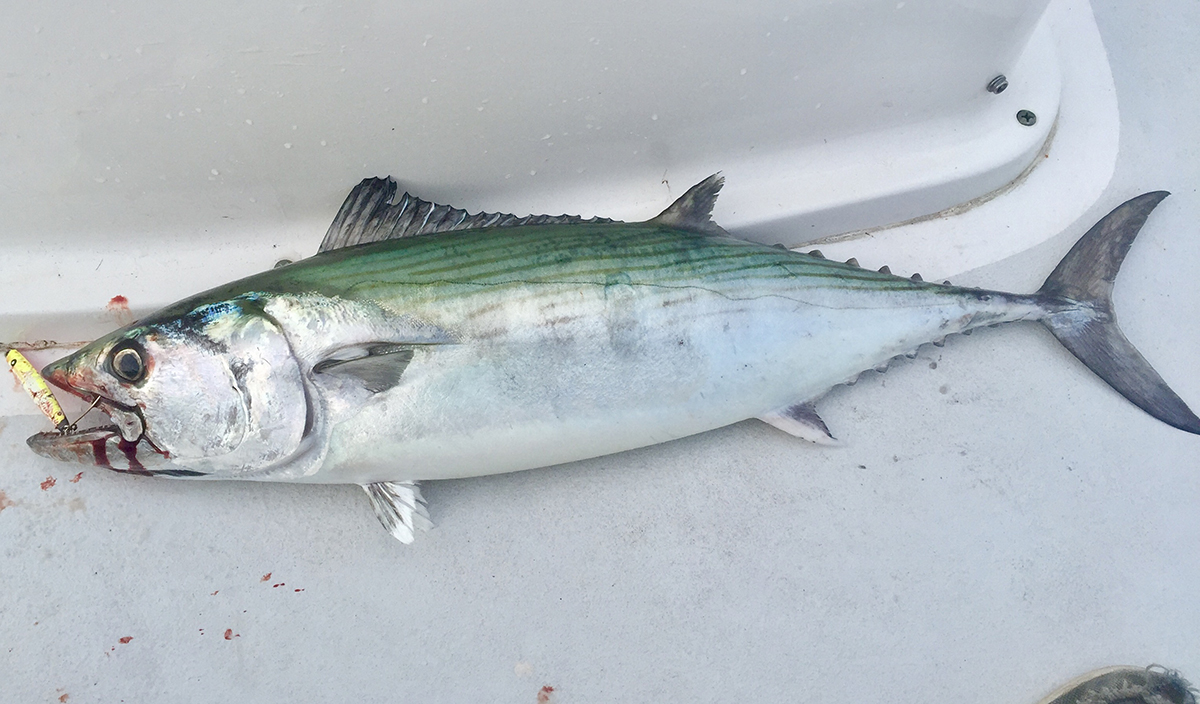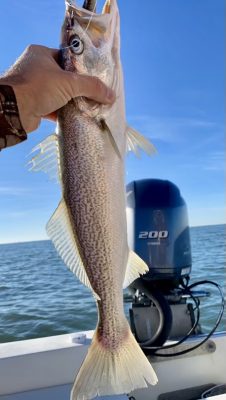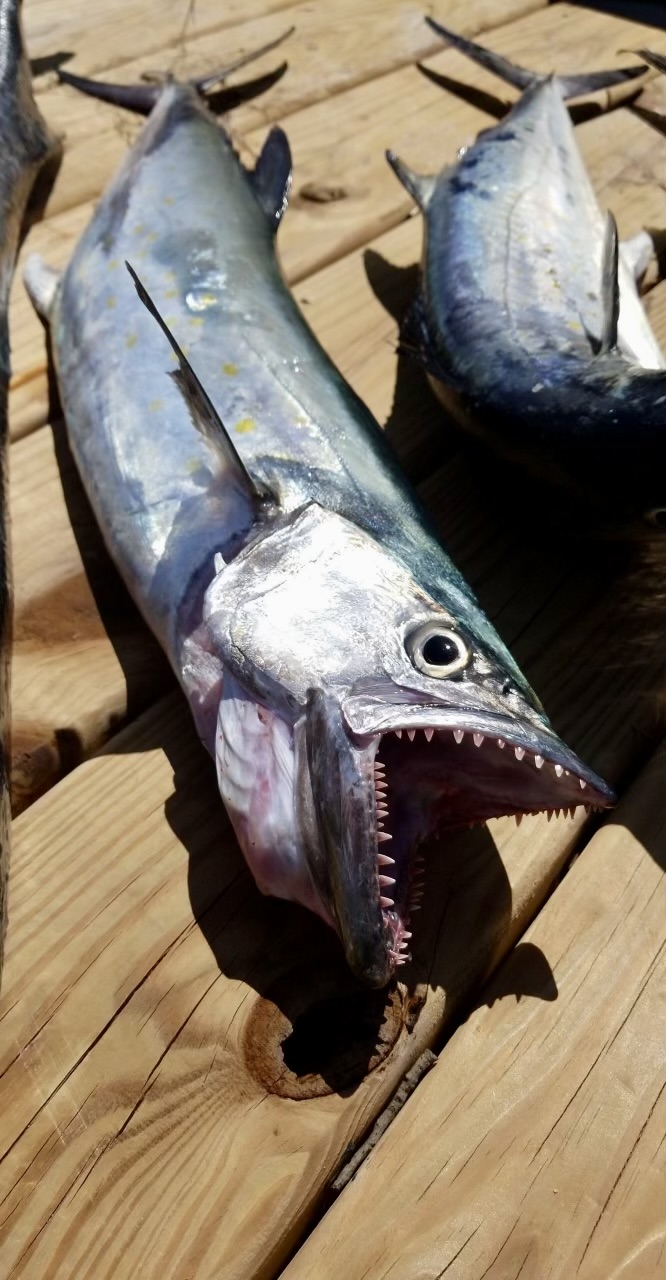
By this time of year, we are getting tired of the cold winds that blow us off the water for days at a time. Fleece pullovers and windbreakers are getting worn out and have stains on top of stains. Thoughts of summer and warm weather are creeping into subconscious, conscious and even unconscious thought. The cold bluster is just getting old.
May brings with it the promise of warm southwest breezes and pleasant days on the water. The ability to finally get in a small boat and go through an inlet, go into the ocean, and catch a fish close to shore is the true sign of approaching summer.
Supporter Spotlight
Check those water temperatures. When it gets above 60, there will be bluefish. Most of them will be on the small size but they will be eager. They’ll eat anything you throw at them. Drop a jig to the bottom. More than likely something will eat it. Pinfish. Spot tail pinfish. Seabass. All kinds of things.

We used to get a lot of big gray trout this way. I keep hearing they are getting more abundant in Long Island Sound. I’ve gotten a few reports here and there about more guys getting them in this area. Not big like we used to get. You can only keep one, so be aware. Let me know if you find any. Primarily, you’ll find small bluefish. Probably lots of them.
Secret’s out
When the water gets above 65, there’s an additional prize that shows up. The Atlantic bonito. This used to be a bit of a secret, but in recent years, on days when the conditions allow, which is a southwest breeze less than 15 knots, you might find a lot of people on your favorite reef or wreck. That’s because they are a lot of fun to catch. They hit hard, run fast, and are super aggressive. You can catch them by casting, vertical jigging, trolling and fly fishing.
When the word gets out, the boats will appear. A real bonus is the fact that these are a nice fish to bring home for the table. Broiled or grilled simply, with a lemon-butter sauce, maybe some capers, or a soy-ginger glaze. Delightful. It’s a rare treat made even more so by their somewhat fleeting appearances the past several years.

If you want to catch one, you need to be prepared ahead of time and then make a Special Forces-style mission and be there at first light. You need to be able to pick up and go.
Supporter Spotlight
My favorite method is fly fishing. I use an 8-weight rod and a sinking line with a baitfish imitating streamer fly tied on the end. Next is vertical jigging with a 2-ounce jigging spoon over high spots on a wreck or hard bottom. Set up a drift over the structure. Drop your jig until it touches bottom. Snap your rod up and let it flutter to the bottom. The strikes will come on the fall. Be on the lookout for any fish feeding on the surface and cast to any you see. Also watch your depth finder. If you see indications of fish off the bottom, try to work your lure at that depth.
Capt. Matt Paylor of Sound-N-Sea Charters in Morehead City will troll with deep-diving swimming plugs such as the Yozuri Crystal Minnow Deep Diver. Don’t add any hardware and keep your leader limited to 30-pound fluorocarbon. Set up a trolling pattern around the structure. The hits will be sudden and forceful. Most of the bonito we see around here are less than 8 pounds. Use light rods and have fun. You might see a whale or even a thresher shark!
Brush up on your Spanish
When we see temperatures pushing toward 70, the Spanish mackerel will appear. The first ones will be a blitz of fish that might consist of the biggest specimens we see for quite some time. If you are out there when this happens you might catch your biggest. It happens to somebody every spring. It might as well be you.
It will not be subtle when they first appear. They come in feasting. I’ve seen birds busting on Spanish mackerel in the spring surf as far down the beach as my eyes would go. It gets crazy at times.

Obviously when they are feasting like this, they aren’t too hard to find. Now you have to decide how you want to catch them.
I always prefer fly fishing. Use an 8- or 6-weight fly rod, and floating line when they’re feeding on top, sinking line if not. Small streamer flies tied to match the size of their prey. About 2 or 3 inches long. Cast it into the melee and hold on. If I’m not doing that I’ll use a very light spinning rod with 10-pound test line and a small jig or casting spoon. Attach it using 40-pound fluorocarbon leader.
If you forget the leader you will lose your lure to their needle-sharp teeth. No other hardware is needed and definitely don’t use a wire leader. They will see those things and recognize it as a fake. Cast to where the fish are feeding and reel as fast as you can. When the bigger ones hit, it feels like you’re snagged. They come on so fast and turn immediately in the other direction. They’ll run a little bit but they don’t have a lot of stamina. Then it will turn into a dogged back and forth kind of fight.
Casting small lures and flies to 3- and 4- (or more) pound Spanish when they are crashing on top is the best way to catch them. However more fish are caught trolling than any other way. Capt. Tom Roller of Waterdog Guide Service in Beaufort tells me he trolls planers and in-line trolling weights with Clark Spoons and finds that to be an easy and productive way to fish all day.
Prepare Spanish mackerel by filleting them properly. The fillets have a dark strip down the middle that many people find unappetizing. Carefully use your knife to remove this. Then cook them using a dry method such as broiling or grilling. I will cover with a spice mixture of some kind, whatever you like. I find that these fish are oilier than some others and butter or other dressing isn’t really needed, even though you might want to have some standing by if you prefer. Keep it simple. Don’t add too much.
That’s pretty much what Spanish mackerel fishing is really about from start to finish.







